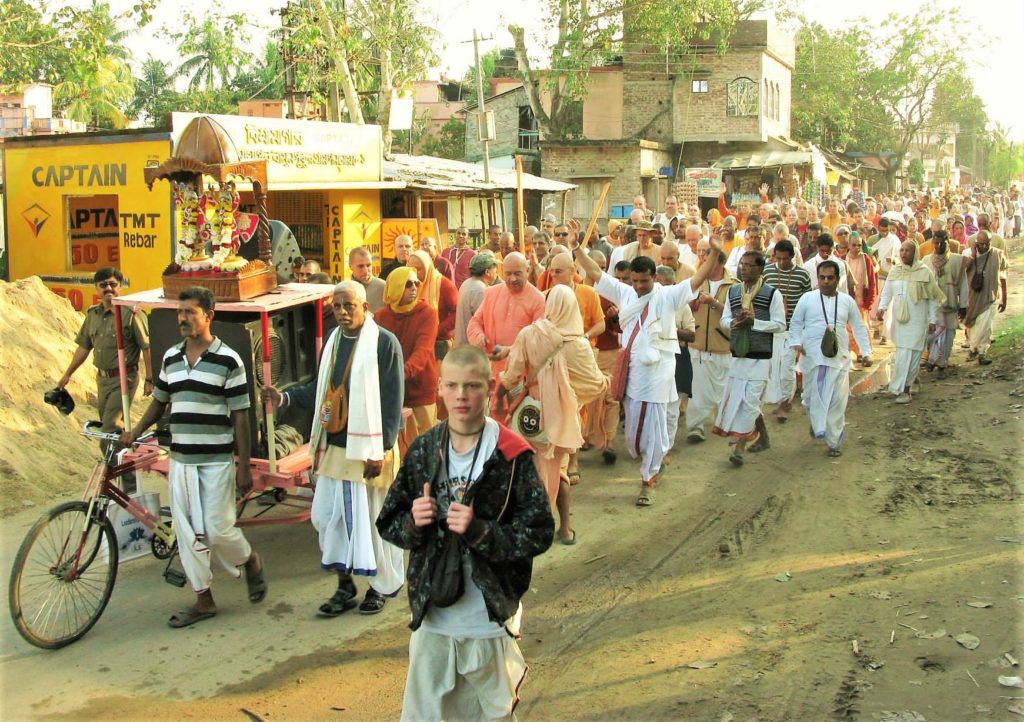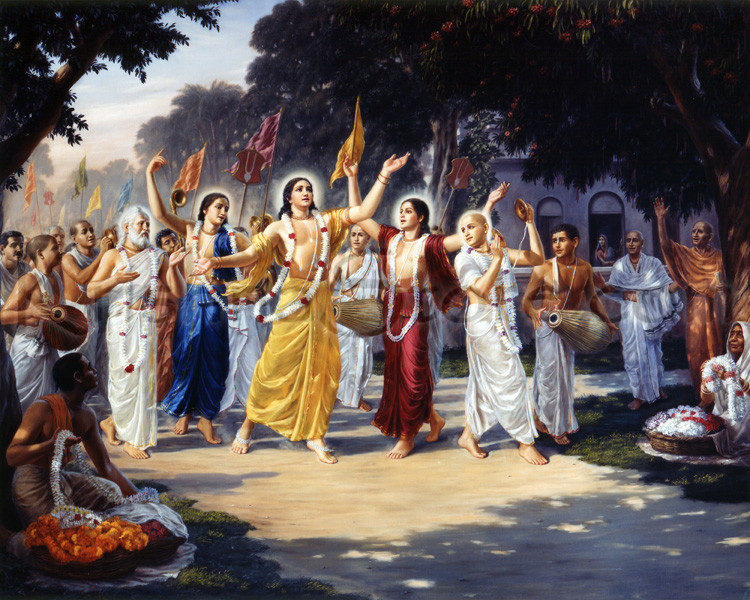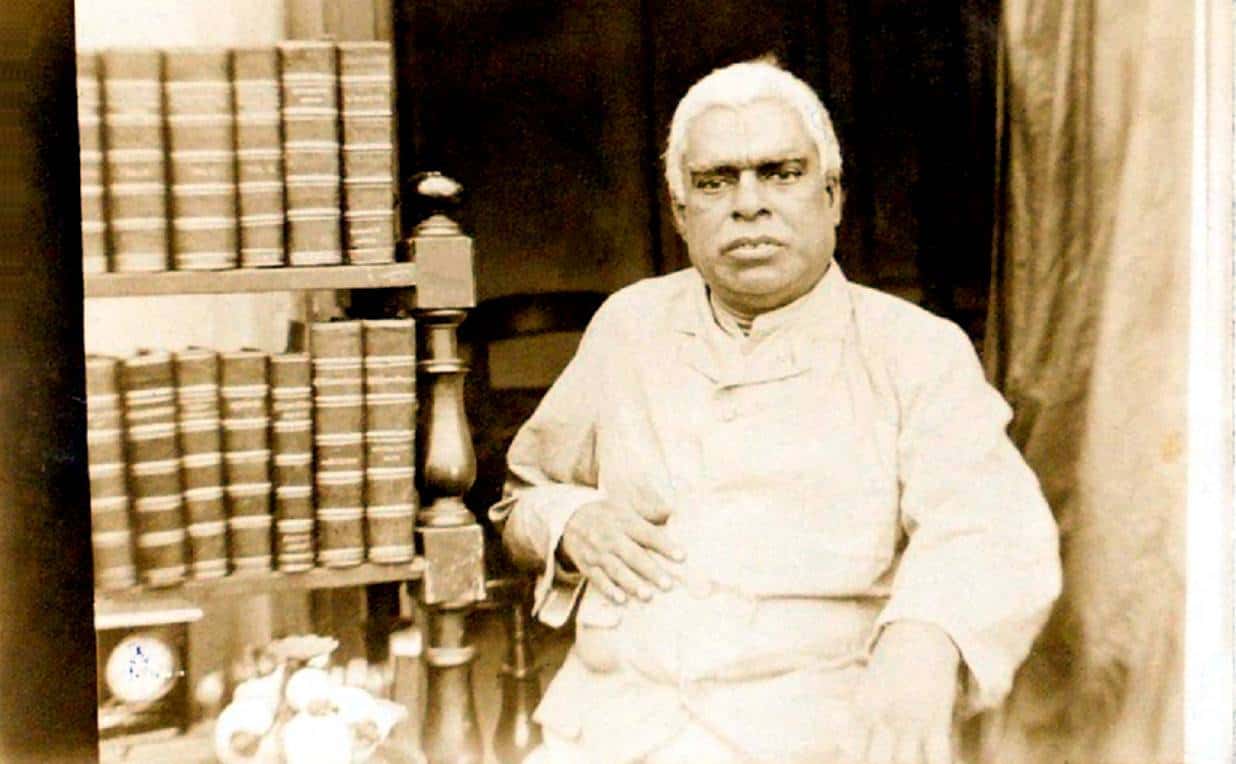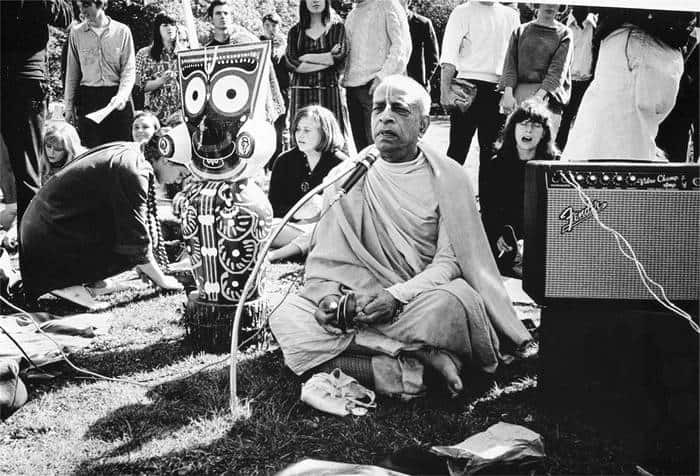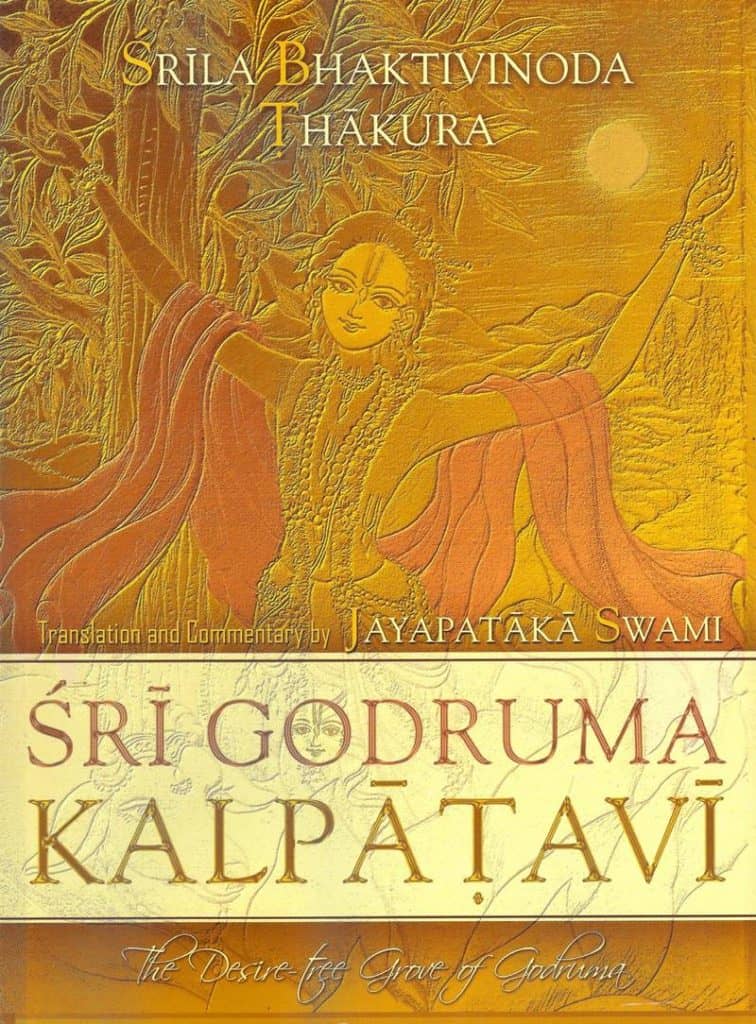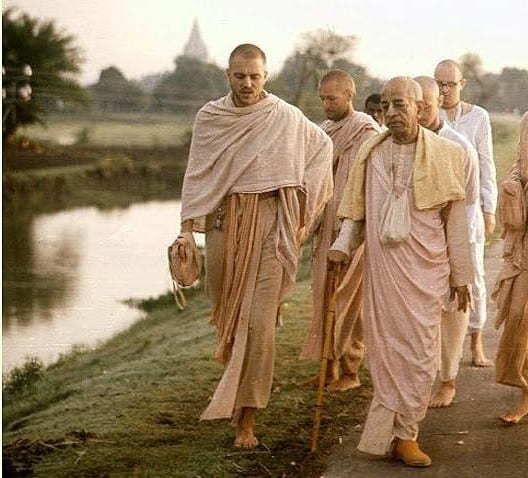Srila Bhaktivinoda Thakura conceived the Nama-hatta, marketplace for the holy name. Marketplaces are defined as places of transactions where products are bought and sold. The Holy Name, of course, is not attained by a series of calculated transactions; it is completely transcendental and beyond the realm of matter. What does it mean, then to purchase and sell an immaterial product? Where does this market exist? If it is free, what does it mean to consider it as having a cost? What is behind this mysterious process and method anyway?
The Age of Kali, although unfortunate in many ways, is praised by the scriptures because only by chanting of the holy-names one can achieve the summum bonum, Love of Godhead. The Supreme personality of Godhead, Lord Caitanya personally appeared in this age to propagate the Holy names.
A little more than 500 years ago, Sri Caitanya Mahaprabhu and Lord Nityananda travelling around Bengal, flooded it with the Holy Names. They had given the simplest process of becoming a devotee:
- Chant Lord Krsna’s Name
- Worship Lord Krsna
- Follow the Instructions of Lord Krsna [Bhagavad Gita and Srimad Bhagavatam]
In recent times, that preaching effort is revived by Srila Bhaktivinoda Thakur and even more recently implemented around the world by Srila Prabhupada, and his followers in ISKCON. Around the world people are chanting the Holy names. In places where there aren’t any temples in the proximity, the devotees make small groups and propagate the Krsna Consciousness. That is what Nama-hatta is in essence, a very simple and effective program which can be universally implemented.
We at Congregational Development Ministry dedicating this month as a “Nama Hatta” month in conjunction with Sri Nityananda Trayodashi. We will share/post News on Nama-hatta around the world.
Setting Up the Marketplace: Remembering Mahaprabhu’s Mood
Mahaprabhu’s preaching is constantly accompanied by sankirtan. Fuelled by compassion for the lost souls, he did not wait for anyone to come to him passively. He did not send out invitations to attend his programs or set up tables with literature for anyone to approach on their own accord.
patrapatra-vicara nahi, nahi sthanasthana
yei yanha paya, tanha kare prema-dana
-CC Adi 7.23
In distributing love of Godhead, Caitanya Mahaprabhu and His associates did not consider who was a fit candidate and who was not, nor where such distribution should or should not take place. They made no conditions. Wherever they got the opportunity, the members of the Panca-tattva distributed love of Godhead.
In the divine heart of Mahaprabhu was a desire was to flood the whole world with Krsna-prema. The sound of the holy name went into the ears of anyone wherever he went whether they had any taste for spiritual life or not. His gift of love flowed directly from the Holy Name.
In the 9th chapter of Adi Lila of Caitanya Charitamrita, Mahaprabhu is described as both a tree of transcendental love, the gardener of that tree, and the distributor of its fruits (Krsna-prema). He explains that if he is the only gardener, he is limited in the amount of fruit he can pick and distribute alone. Furthermore, some may accept and others not. Therefore, he ordered each and everyone to help him take up this task to spread the Holy Name everywhere; to become guru and deliver everyone. His goal was nothing short of delivering the entire universe, so preaching could take place everywhere.
Lord Nityananda: Primary Distributor in the Nama-hatta
Eagerness is a primary attribute of those who are inspired to distribute the Holy Name. The greatest example of this, of course, is Lord Nityananda. He went forth carrying the order of Lord Caitanya: “Speak about Krsna, worship Krsna, and teach others about Krsna,” (Sri Caitanya Bhagavat Madhya 13.8.)
He went from door to door, very humbly begging anyone and everyone to chant. He did this with a great feeling of respect for all, expecting no respect in return. Srila Bhaktivinoda Thakur has written:
jadi nama kinbe, bhai
amar sange calo, mahajaner kache jai
O brother, if you want to buy the Holy Name, then go with me. We must go to the presence of that great soul, Nityananda.
The Innovator of the Marketplace: Srila Bhaktivinoda Thakura
Srila Bhaktivinoda Thakura personally travelled to so many places and established over 500 Nama-hatta sanghas. He organised roles for running the Nama-hatta smoothly. Each Nama-hatta was headed by a commander who took care of the members of the Nama-hatta (employees). He designated the traveling preachers who went from door to door as salesmen. Finally, he considered himself simply as the sweeper whose purpose was to help maintain purity by speaking Harikatha and singing kirtans at the houses he visited.
Srila Bhaktivinoda Thakura’s modern-day Nama-hatta mission continued with Srila Prabhupada. His disciples including HH Jayapataka Swami (Minister for Congregational Preaching), HH Bhakti Raghava Maharaja, Bhakti Purushottama Swami, and Gauranga Prem Swami have expanded these Nama-hatta by the thousands throughout West Bengal, Bihar, and Orissa. This enthusiasm has rippled out and initiated thousands of more Nama-hattas all over the world.
What Do Nama-hattas Accomplish?
• Provide regular opportunities to associate with devotees even if they live far from temples
• Support advancement in spiritual life for householders, even as they are busy with work and family
• Serve as expansions of temples to reach out and include all
• Connect aspirants to Harinam initiations
• Avail welcoming places for those who have received Srila Prabhupada’s books and other various newcomers
• Preaching facilities without taking funds from temple collection
• Facilitate practice for preachers, including young people and women
Our Call to Action Within the Nama-hatta
When we regularly honor and remember Mahaprabhu’s mood and Srila Bhaktivinoda’s Nama-hatta method, we gain the necessary enthusiasm to carry out this divine mission. If we can get even a tiny bit of their compassion and magnanimity, our efforts for spreading Harinam sankirtan and preaching will be blessed.
Through sincere adherence to the Nama-hatta structure, the movement gets nurtured and grows. Bhakti-vriksha groups have been implemented through the Congregational Preaching Developmental Ministry of ISKCON in order to carry out the order of our “divine gardener” Mahaprabhu and to please our previous Acaryas including our Founder, His Divine Grace A.C. Bhaktivedanta Swami Srila Prabhupada.
THE HISTORY OF NAMA HATTA IN ISKCON
-By Bhakti Raghava Swami —
The First Nama Hatta Sanga
The Nama Hatta program officially started in the month of September 1979 in Sri Dham Mayapur. At that time, a group of enthusiastic villagers living near the Mayapur Chandradoya Mandir filled in their Nama Hatta Application Form and officially became the first registered Nama Hatta Sanga. Earlier that year, His Holiness Jayapataka Maharaja had held a meeting with some devotees serving in Sri Mayapur regarding introducing the Nama Hatta program originally set up by Srila Bhaktivinoda Thakura as outlined in his Godruma Kalpatavi. The small book was little known to most devotees since it had not yet been translated from the original Bengali text. I had been serving as the New Bhakta Director for about one year and when invited to attend the meeting I showed interest to become involved, somehow getting a small glimpse of the program’s large potential.
Humble Beginnings
The Nama Hatta activities started on a very small scale with only a handful of devotees and with very little facilities. The only rooms which could be made available at that time were located in the basement of the Cakra Building, referred to then as the “long building”. I chose the last two rooms to the extreme east side of the building, making one as my office and the other as my residence. We had no budget for the Nama Hatta program and no source of income as well. The program was initially separate from the temple management and was mainly financed by Jayapataka Maharaja. In those early days, and until I continued to serve in Sri Mayapur up until 1986, we had no computers, no cell phones, no cameras and no vehicles, only a couple of bicycles. As the program expanded, we required more and more space, which was gradually made available in the basement of the “long building”. The number of preachers joining the Nama Hatta Department also gradually increased. For many years the Nama Hatta office remained located in the basement of the long building, somewhat hidden and little known to the general public.
Nama Hatta
Misunderstood in its initial stages of development, the Nama Hatta program could not be so easily understood or sometimes appreciated by many devotees because it involved mostly devotees living outside our temple. It was somewhat of a struggle to get the general temple devotees and even the administration to accept the program. I was initially given the title “Nama Hatta Governing Director” which was changed shortly to “Nama Hatta Regional Director”, a less threatening title. When we decided to hold the first Nam Hatta Sammelon in the year 1980, something that became a yearly affair attracting thousands of Nama Hatta devotees, the Mayapur Administration had a little difficulty relating to the event because the program was organized somewhat independent from the temple. Here I was as the Regional Director of Nama Hatta inviting the Temple President to our function, in his temple. But gradually, by Lord Caitanya’s mercy and that of the devotees, the program became more integrated and accepted by more and more people. I remember setting up a book table during the yearly seminars held during the Gaura Purnima Festival in Sri Dham Mayapur; very few foreign devotees could relate to the Nama Hatta program.
Nama Hatta Sammelon’s
To bring the Nama Hatta members closer together and to enthuse them in their preaching work, as well as to increase the number of new Nama Hatta Sangas, the Nama Hatta Office organized a yearly Sammelon. This generally took place just before or after the Vyasapuja of His Holiness Jayapataka Maharaja. It was a big event drawing Nama Hatta groups from remote villages mainly of W. Bengal and Orissa. They would all converge on Sri Mayapur, each bringing their colorful Nama Hatta banners proudly displaying the name of their village and district. Various awards and prizes such as mrdangas, karatals, Deity paraphernalia, books, etc., were given as incentives to those Nama Hatta Sangas showing the best performances in their sadhana practices and preaching efforts.
Pioneering Devotees
Two of the earlier pioneers to the Nama Hatta program were Gauranga Prema Prabhu, who later became His Holiness Gauranga Prema Maharaja and now heads up the Nama Hatta Department and Gaura Chandra Prabhu, who is presently the most senior preacher of Nama Hatta assisting His Holiness Gauranga Prema Maharaja. Gaura Chandra Prabhu came from the District of Balasore in the Province of Orissa. He was barely 16 years of age when he arrived in Sri Mayapur to join as a full-time devotee, and soon after as a full-time preacher under the Nama Hatta Department. Both these devotees have now been connected with the program for close to 30 years and remain the main inspirational leaders. Other pioneers from W. Bengal included Svetadwipa Prabhu, Braja Raja Prabhu and Koladwipa Prabhu, along with many other preachers.
Enthusiastic “Dadu”
One of the most enthusiastic devotees involved in the Nama Hatta program was “Dadu”. When I was still the New Bhakti Director in Sri Mayapur, one day an old man with long matted hair appeared in my office. He was around 80 years old and had been living in a cave for many years somewhere in Assam. Somehow, by the mercy of some travelling preachers, he had received a Back to Godhead magazine. Soon after reading the magazine he came to Sri Mayapur with the idea of joining as a full-time devotee. We didn’t really know what to make of him because he was already quite old and all our new bhaktas were quite young. He must have been wearing his matted hair for decades because when undone it touched the floor. For the first night at the temple, he decided to sleep on the floor in the hallway of the long building. The next day we had more serious discussions with him about how it may be somewhat difficult for him to become a full-time devotee at his age. Seeing his strong determination to join as a full-time devotee we told him that he had to cut off his long-matted hair. He immediately proceeded to the Ganga close-by and shaved off his long hair thus joining as a full-time devotee. Soon after becoming a full-time devotee he joined the Nama Hatta preaching programs. He would attend the Nama Hatta function in local villages and very enthusiastically stand on the stage and encouraging everyone to chant the holy names.
Pioneering Days
In the beginning, the Nama Hatta devotees had to manage with but few facilities. The devotees would travel by public transport (bus, train, boat, bullock cart and walking) to different parts of W. Bengal, Orissa and Assam. As soon as we started to register Nama Hatta Sanghas, more and more village people came to know about the program and often people would show up at the Nama Hatta office wanting to become registered. The registration procedure was very simple. The registration fee was nominal and the regulations to follow were also kept at a minimum. At least five people of the same village were needed to register as a Nama Hatta Sanga. To qualify as a registered Nama Hatta Sanga, they agreed to meet once a week in their village and to hold Harinama as well as hear from sastra. Members were encouraged to chant a few rounds of japa and whenever possible to visit Sri Dham Mayapur. So, it was very simple. Whenever possible we would also visit their village. For me it was very inspiring to see so many people take to the practice of devotional service. Within the first few years we had actually registered over 1000 Nama Hatta Sangas.
The Samskar Patra
One of the attractive and innovative methods introduced by Jayapataka Maharaja to connect more people to the Nama Hatta preaching was the “Samskar Patra”, an official Nama Hatta “Oath Card”, whereby one would pledge to chant at least one round of the Hare Krsna Maha-mantra every day. Dozens, sometimes even hundreds, of enthusiastic participants attending the pandal programs would line up after each program and would promise to chant at least one round of the Maha mantra. Some people would keep this card with them for years and years proudly showing it to our preachers when coming to the temple, still remembering the day when they received their Samskar Patra.
North Bengal Tour and the German Bus
Every year an annual tour was organized in various parts of W. Bengal at which time Jayapataka Maharaja would travel with his own special German made bus and entourage of devotees. The bus had an inbuilt bed inside so that Maharaja could stay comfortably, as in many places the facilities were not always present. The bus also enabled Maharaja to work on his computer which he carried during his preaching tours. This annual North Bengal tour helped to make many devotees and thus boosted the preaching activities of Nama Hatta considerably. It was during these tours that large pandal programs would be organized attracting thousands of curious on-lookers. To arrange these tours required quite a bit of planning, most of which was done by our Bengali preachers travelling ahead to make such arrangements. As the Nama Hatta members became more familiar with the tours, they themselves made all the arrangements for staying and for prasadam. At times up to 50 devotees or more would be travelling with Jayapataka Maharaja on these tours. To drive this German bus, foreign devotees with good driving records were selected. Once the regular bus driver for Jayapataka Maharaja fell ill and could not drive his bus. I offered to drive the bus although I had not driven such a big bus before. When I was in Canada, I had previously obtained my chauffer’s license which allows one to drive various vehicles. So, for quite a few days I became Maharaja’s official driver. I was pleased to hear Maharaja comment after the tour that my driving was quite smooth compared to some of the previous drivers.
Preaching with His Holiness Jayapataka Maharaj
His Holiness Jayapataka Maharaja took upon himself many great austerities to establish and promote the Nama Hatta program, from its early inception to its present-day development. I remember how he would sometimes arrive from oversees, and from the airport he would have to dash to the Howrah station in Calcutta to catch a night train which would take him to some remote village where programs had already been scheduled. He would make his way to the local pandal, sometimes using his own small flashlight as no one had thought of getting a proper torch or lantern. In those early days, the arrangements in the village were quite simple and somewhat humble in nature. Still Maharaja was always ready to accept any and all inconveniences to hold programs and preach in the local Bengali language to the local eager listeners. Because of on-going responsibilities in other parts of the world, whenever Jayapataka Maharaja would travel on these tours, he would have to keep up with his communication so he would travel with his computer. Devotees had to arrange for an electric connection to ensure that his computer could endure pass the limited time of batteries in those earlier days (he generally had one additional battery for his computer but he probably needed more than one). He would often work late in the evening to finish off some important reports or catch up on e-mail communication. The electric wires would be coming to his bus and in this way his work could continue. I am sure it happened on more than one occasion but I personally saw how, on one occasion, some of the local village people, not conscious of the computer work going on inside the bus, would not be cautious in walking around the bus and accidently caused the lines to become disconnected. Maharaja was sometimes a bit in despair having lost a lot of unsaved material. Jayapataka Maharaja was always very caring to all the devotees, including myself. Once when returning to India from a preaching tour outside of India, knowing that the working conditions in the Nama Hatta basement office were not so ideal, he came to the office and presented me with a brand-new electric wall fan which he had carried all the way from some foreign country to India. I very much appreciated the gesture.
Nama Hatta Today
Today the Nama Hatta program has developed very widely, having its own ministry called the ISKCON Congregational Development Ministry with His Holiness Jayapataka Maharaja as the Co-Minister with Kaunteya Prabhu. The Nama Hatta devotees in Sri Dhama Mayapura now have a large building to accommodate the thousands of Nama Hatta members who visit the Holy Dhama every year, and to coordinate the many activities of their department. There are close to 100 brahmacari devotees divided in several groups covering various parts of W. Bengal and Orissa. A number of buses are now available to serve the Nama Hatta mission. Thus, by the mercy of the previous Acaryas and the determined efforts of today’s Nama Hatta preachers, the prediction of Lord Caitanya MahaPrabhu is gradually coming to pass with the spreading of the holy names in every town and village
Nama Hatta and the Future
Those who joined the Hare Krsna Movement in the days when Srila Prabhupada was himself present recall how our conception of who is a devotee has evolved over the years from a somewhat narrow and exclusive understanding, to a wider and more inclusive one. For example, in the early days, if one was not living in the temple, he was considered in maya. In a similar way, if someone was not shaved up and wearing a sikha, he was also considered in maya. We have gradually matured and have been able to encompass and embrace as devotees, those who live outside our temples working in some profession. From our immediate congregation of devotees closely connected with the temple, grew the acceptance of those who were living far from our temples like the Nama Hatta members. When I was involved with the Nama Hatta preaching program, I could sense the initial reluctance on the part of many devotees in accepting Nama Hatta devotees as being very much part of Lord Caitanya’s movement. This same resistance is now manifest in another form when considering yet another major area of Srila Prabhupada’s overall vision, the varnasrama mission. This is of special importance to the Nama Hatta preaching work. It can only be easily understood if we become familiar with the expressed desires of Srila Prabhupada for spreading Krsna consciousness to the wider society, what Srila Prabhupada termed as “large scale” preaching. These instructions and this vision of Srila Prabhupada are given in his essay called Conception of Gita Nagari written in the 1956 Back to Godhead magazine.
Nama Hatta and the Varnasrama Mission
Srila Prabhupada outlined four major phases for the overall preaching movement of Lord Caitanya, to which he gave specific names. He has coined the first phase as the “Sankirtan Movement” referring to the spreading of the holy names and the large-scale distribution of books. He called the second phase as the “Temple Worship Movement” referring to establishing temples and installing Deities. He referred to the third phase as the “Spiritual Initiation Movement” referring to congregational preaching, of which Nama Hatta has been the foremost program. All these three phases continue to be major areas of development within our ISKCON society. However, the fourth phase, referred to by Srila Prabhupada as the “Classless Society Movement” (the varnasrama mission), is yet to unfold as it should. All these four phases are meant to support and complement one another. All of them have a bright future if we make the proper connection and give all four the support needed.
